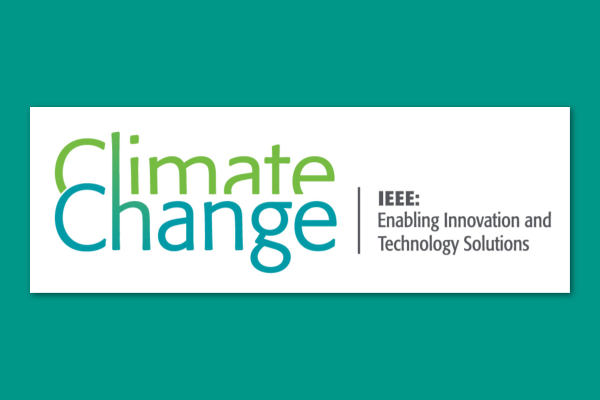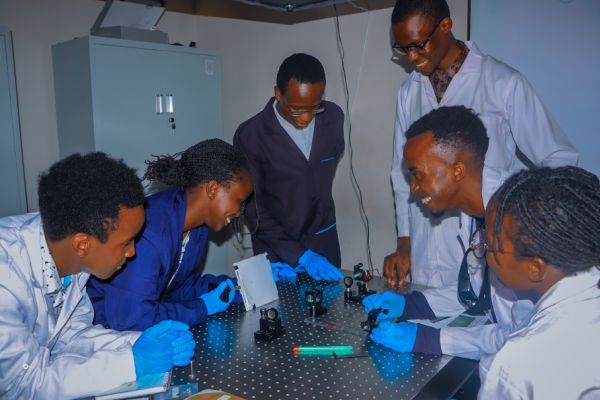Recent years have witnessed dramatic shifts in our environment, marked by the increasing prevalence of temperature fluctuations. In the face of these challenges, the importance of sustainability emerges as an essential element across various aspects of our lives. As members of the IEEE, one of the largest engineering bodies globally, we bear a responsibility to address climate change. Understanding the gravity of the situation considering its profound impact on ecosystems, weather patterns, sea levels, biodiversity, and the challenges it poses to our environment, societies, and economies, it is crucial for IEEE to contribute not only to its community but also on a larger scale for the global community.

Climate incorporates various components such as temperature, humidity, precipitation, wind patterns, and seasonal variations, characterizing the enduring meteorological conditions in a specific region. Since the 1800s, the primary contributors to climate change have been driven predominantly by human activities like the burning of fossil fuels, deforestation, and industrial operations that emit greenhouse gasses into the atmosphere. These gasses trap solar heat, which leads to a gradual increase in Earth’s average temperature. Climate change is having a substantial impact on the environment, cultures, and economy, and its effects go beyond ecosystems, which have a major impact on weather patterns, sea levels, biodiversity, cultures, and the economy. Understanding climate change is crucial to mitigating its consequences, adjusting to the changing surroundings, and embracing sustainable practices.
The Paris Agreement on Climate Change:
The Paris Agreement, an international treaty adopted in 2015 during COP 21, signifies a pivotal moment in the global response to climate change. It binds all countries to reduce their greenhouse gas emissions and increase their capacity to withstand climate change and sustainability. This agreement is essential to reducing the growing effects of climate change, with a 98% chance of setting new temperature records and a concerning 66% chance of global temperatures rising by 1.5 degrees Celsius beyond pre-industrial levels. In addition to financial measures, the agreement establishes a comprehensive framework encompassing technical aspects and capacity building. The foundation of the Paris Agreement is the Nationally Determined Contributions (NDCs), which identify each nation’s efforts to reduce the national emissions and prepare for the effects of climate change. Every five years, Parties are obliged to submit updated NDCs that include goals, objectives, and strategies for achieving climate change. The fact that the present NDCs are not on track towards achieving the goals of the agreement emphasizes the necessity of further commitment, financial support, and capacity building.
Key Objectives of the Paris Agreement:
- Limit the average global temperature increase to well below 2 degrees Celsius and pursue efforts to limit it to 1.5 degrees Celsius.
- Enhance resilience to climate impacts.
- Align financial flows with climate objectives.
IEEE’s Role in Climate Change Initiatives:
IEEE plays a significant role in climate change initiatives, particularly through its focus on technology development and transfer. Article 10 of the Paris Agreement emphasizes the importance of technological innovation and technology transfer. Leveraging its expertise and resources in technology and engineering, IEEE promotes research, innovation, and the development of sustainable solutions. Initiatives in renewable energy, smart grids, and energy efficiency demonstrate IEEE’s commitment to mitigating climate change. IEEE addresses climate change through various organizations and initiatives. IEEE Ad Hoc Committee to Coordinate IEEE’s Response to Climate Change (CCIRCC), IEEE Future Directions, IEEE Standard Associations, Planet Positive 2030, IEEE Climate Change Technical Community, and IEEE Young Professionals (YP) Climate Change and Sustainability Task Force (CSTF) are actively contributing to the global efforts.
IEEE CCIRCC: The 2022 IEEE President-Elect, Saifur Rahman formed the IEEE Ad Hoc Committee to Coordinate IEEE’s Response to Climate Change (CCIRCC) which is tasked with developing a comprehensive strategy to synchronize and guide IEEE’s response to global climate shifts. Committee members are expected to dedicate time to collaborate with team members and engage with core IEEE constituencies to ensure successful adoption of recommendations. Collaboration with other committees/boards is encouraged, and recommendations include identifying ongoing efforts across IEEE, proposing new programs and activities, developing a climate change policy statement for consideration by the IEEE Board, and identifying key external partners for cooperation. The CCIRCC program later evolved into the Committee on Technology for a Sustainable Climate (CTSC). CTSC operates as an ad hoc committee within the IEEE Strategy and Alignment Committee, assuming the responsibilities previously held by the IEEE Board ad hoc Committee to Coordinate IEEE’s Response to Climate Change (CCIRCC) as of January this year.
IEEE Future Directions: IEEE Future Directions focuses on emerging technologies and their societal impact. Through research, innovation, and the development of sustainable solutions, IEEE Future Directions addresses critical areas such as renewable energy, smart grids, and energy efficiency.
Planet Positive 2030: Planet Positive 2030, an IEEE initiative, aims to create a sustainable and positive impact on the planet through technological innovations supported by the IEEE Standards Association (IEEE SA). This initiative aligns with the goals of the Paris Agreement by fostering advancements in areas such as clean energy, environmental monitoring, and sustainable development.
IEEE Young Professionals (YP) Climate Change and Sustainability Task Force (CSTF): The recently established IEEE Young Professional Climate and Sustainability Task Force (CSTF) plays a vital role in engaging early career professionals in climate sustainability and technology. Led by Dr. Sajith Wijesuriya, the CSTF creates tools, resources, and support mechanisms for young professionals, serves as a focal point for engagement, acts as an interface within IEEE, and collaborates with external entities sharing common goals.
Core Functions of CSTF:
- Creating tools and resources for early career professionals.
- Serving as a focal point for YPs engaging in climate sustainability.
- Acting as an interface between YPs and other IEEE organizations.
- Acting as an interface between IEEE YPs and external youth-driven entities with common goals.
IEEE Climate Change Technical Community: Members of the IEEE Technical Community represent diverse stakeholder groups across various IEEE disciplines. The research conducted by IEEE scientists in this domain encompasses sustainable energy systems, climate-resilient infrastructure, wildfire mitigation, weather pattern systems, ozone recovery, and more. The IEEE Climate Change Initiative serves as a centralized repository for gathering all IEEE resources, including but not limited to scholarly publications, events, conference proceedings, technical standards, and other materials related to climate change. This consolidation aims to promote the exchange of technical knowledge and information crucial for addressing the pressing climate issues our planet is currently facing.
How can the IEEE Photonics Society be a part of this Climate Change initiative? The IEEE Photonics Society, with its focus on optics, photonics, fiber optics, lasers, biophotonics, bio-optics, nanotechnology, and nanophotonics, sustainable computing can play a crucial role in addressing climate change by leveraging its expertise in these cutting-edge technologies. Here are several ways in which professionals in these fields can contribute:
- Renewable Energy Technologies:
- Solar Photovoltaics: Photonics professionals can contribute to advancements in solar photovoltaic technology, improving efficiency and reducing costs, thereby making solar energy more accessible and widespread.
- Optical Materials for Energy Storage: Researchers in photonics can explore materials and techniques for improving energy storage solutions, such as advanced batteries or other energy storage devices.
- Energy Efficiency:
- Optical Communications and Fiber Optics: Photonics experts can play a role in enhancing the efficiency of optical communication systems and fiber optics, contributing to the development of faster and more energy-efficient data transmission networks.
- Optical Sensors for Energy Monitoring: Photonics technologies can be employed to develop highly sensitive optical sensors for monitoring energy consumption, helping to identify areas where energy efficiency improvements can be made.
- Environmental Monitoring:
- Lidar Technology: Photonics professionals working with Lidar (Light Detection and Ranging) can contribute to environmental monitoring by providing high-resolution, three-dimensional mapping. This technology is crucial for assessing deforestation, monitoring carbon sequestration, and understanding changes in land use.
- Spectroscopy: Techniques such as spectroscopy, commonly used in photonics, can aid in environmental monitoring by analyzing the composition of gasses and pollutants in the atmosphere.
- Biophotonics and Bio-Optics:
- Environmental Sensing and Monitoring: Biophotonics and bio-optics can be applied to develop advanced sensing technologies for monitoring environmental changes, studying ecosystems, and assessing the impact of climate change on biodiversity.
- Agricultural Applications: Photonics can contribute to precision agriculture by providing advanced imaging and sensing technologies, optimizing resource usage, and reducing environmental impact.
- Nanotechnology and Nanophotonics:
- Nanoscale Materials for Energy Solutions: Nanophotonics professionals can explore nanomaterials and nanoscale structures to enhance the efficiency of energy harvesting devices, such as solar cells, and contribute to the development of novel energy solutions.
- Nanophotonics for Environmental Sensing: Nanophotonics technologies can enable the development of highly sensitive and miniaturized sensors for real-time environmental monitoring.
- Educational and Outreach Initiatives:
- IEEE Photonics Society can organize educational programs, workshops, and conferences focused on the intersection of photonics and climate change, fostering collaboration and knowledge exchange among professionals.
- Technology Transfer and Collaboration:
- Encouraging collaboration between academia, industry, and government organizations can facilitate the transfer of photonics technologies to real-world applications addressing climate change challenges.
As climate change continues to impact our planet, IEEE, with its global influence and technological expertise, is well-positioned to drive positive change. By aligning with the Paris Agreement’s objectives and actively participating in initiatives like the IEEE YP CSTF, IEEE Photonics Society and its professionals in optics, photonics, and related fields can also make substantial contributions to addressing climate change by advancing technologies, monitoring environmental parameters, and promoting energy efficiency solutions for generations to come. Collaboration and interdisciplinary approaches will be essential to harness the full potential of photonics in the fight against climate change. The time to act is now, and IEEE members have a unique opportunity to be at the forefront of global efforts in combating climate change.
Contributions provided by: Naznin Akter





